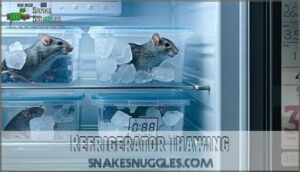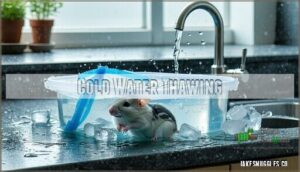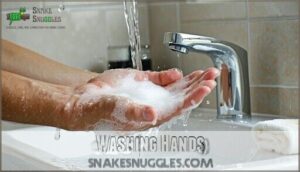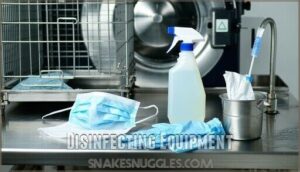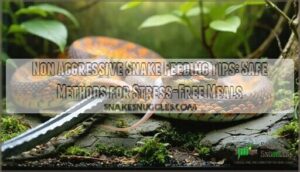This site is supported by our readers. We may earn a commission, at no cost to you, if you purchase through links.
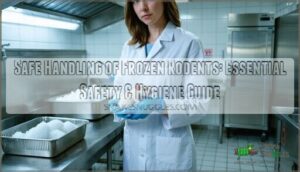
Always wash your hands thoroughly before and after handling, and never eat or drink during the process. Thaw rodents in the refrigerator or cold water—never at room temperature where bacteria can multiply rapidly.
Clean all surfaces with disinfectant, store rodents properly labeled in your freezer, and keep them separate from human food. Cross-contamination isn’t just a concern—it’s a real health risk that proper technique can easily prevent.
The right approach transforms what seems like a risky task into a straightforward routine with some insider knowledge about timing and temperature control.
Table Of Contents
- Key Takeaways
- Frozen Rodent Safety
- Rodent Borne Diseases
- Safe Thawing Methods
- Hygiene Practices
- Storage Guidelines
- Frequently Asked Questions (FAQs)
- How long can I leave a frozen rat out to thaw?
- Are frozen mice clean?
- Do frozen mice carry salmonella?
- What temperature kills parasites in frozen rodents?
- How long can frozen rodents stay safe?
- Can you refreeze thawed rodents safely?
- What signs indicate spoiled frozen rodents?
- Are wild-caught rodents safer than bred?
- Conclusion
Key Takeaways
- Always wear protective gloves and use dedicated tongs when handling frozen rodents to prevent direct contact with bacteria like Salmonella
- Thaw rodents safely in the refrigerator (2-4 hours) or cold water, never at room temperature where harmful bacteria multiply rapidly
- Clean and disinfect all surfaces, equipment, and hands thoroughly after handling to prevent cross-contamination with your food and living spaces
- Store frozen rodents at 0°F or below, label them with dates, and use within 6-12 months while keeping them separate from human food to maintain food safety
Frozen Rodent Safety
When handling frozen rodents for feeding reptiles or birds of prey, you must prioritize safety to prevent disease transmission and contamination.
Proper thawing, storage, and hygiene practices protect both you and your animals from harmful bacteria like Salmonella.
Handling Frozen Mice
When handling frozen mice for reptile food, you’ll need proper technique to maintain safety standards.
Size selection matters for species differences in snake food requirements.
Here’s your essential handling checklist:
- Wear protective gloves – Direct contact spreads bacteria to your hands
- Use dedicated tongs – Keep frozen rodents away from your skin
- Check for freezer burn – Damaged feeder rodents lose mice nutrition value
- Select appropriate sizes – Match frozen mice to your reptile’s feeding needs
Always source from ethical suppliers who prioritize enrichment feeding practices for healthier frozen rodents.
Thawing Frozen Rats
Thawing frozen rats requires careful temperature control to maintain food safety for your reptiles.
Thawing time varies substantially based on rat size – adult rats need 4-6 hours while pinkies thaw in 30-60 minutes.
Use dedicated thawing containers filled with cool water, never warm water which promotes bacterial growth.
Visual inspection helps confirm complete thawing before feeding your snake food.
Preventing Cross Contamination
Cross contamination spreads bacteria from frozen rats to other surfaces. You’ll need separate utensils for each rodent and dedicated freezers for storage. Surface sanitization prevents harmful bacteria transfer during rodent care. Inadequate prey presentation can also lead to feeding refusal.
- Use thawing barriers like sealed bags or containers
- Practice proper disposal of contaminated materials immediately
- Maintain safe handling protocols throughout rodent nutrition preparation
Rodent Borne Diseases
Understanding potential diseases is key to protecting yourself during rodent care activities. Over 35 substantial diseases link to rodents, making safe handling practices your first line of defense.
Rodent-borne diseases pose serious risks—proper handling protects you from 35+ harmful pathogens.
Rodent-borne pathogens pose serious health risks through multiple transmission routes. You can contract these diseases through direct contact with rodent waste, breathing contaminated dust particles, or handling infected materials without proper protection.
| Disease | Transmission Method |
|---|---|
| Hantavirus Pulmonary Syndrome | Inhaling dust from dried rodent droppings |
| Lymphocytic Choriomeningitis | Contact with fresh urine or nesting materials |
| Salmonellosis | Consuming contaminated food or water |
| Leptospirosis | Skin contact with infected urine |
| Plague | Flea bites from infected rodents |
Prevention centers on proper rodent storage and safe handling techniques. Always wear gloves when managing frozen specimens and avoid creating dust clouds during cleanup. Your rodent feeding and rodent nutrition practices should include sanitizing work surfaces before and after use. Proper ventilation reduces airborne pathogen risks substantially. It’s vital to learn about common rodent diseases to take necessary precautions.
Safe Thawing Methods
Proper thawing prevents harmful bacteria from growing on frozen rodents and keeps you safe during handling.
You’ll need to choose between refrigerator thawing for planned feeding or cold water methods for faster results.
Refrigerator Thawing
Refrigerator safety guarantees ideal thawing conditions for your reptile diet needs. This method provides superior temperature control compared to other thawing methods.
Follow these refrigerator thawing guidelines:
- Set temperature between 35-40°F for proper frozen storage conditions
- Allow 2 hours for mice, 4-5 hours for rats based on frozen rodent size
- Use within 24 hours after complete thawing for safety
- Store in leak-proof containers to prevent contamination during rodent storage
- Label with thawing times to track when thawing rodents began
It’s also vital to understand safe thawing methods to maintain the quality of frozen rodents.
Cold Water Thawing
Quick thawing techniques using cold water offer faster results than refrigerator methods.
Place your frozen rodent in a leak-proof bag, then submerge it in cold water. Change the water every thirty minutes to maintain proper water temperature and prevent bacterial growth.
This frozen handling method thaws adult rats in about one hour while maintaining thawing safety standards for your reptile diet needs.
Proper handling and thawing techniques involve understanding safe thawing methods to guarantee the health and safety of your snake.
Avoiding Bacterial Growth
Bacteria multiplies rapidly above 40°F, making temperature monitoring essential for microbial control during thawing.
Keep temperatures below 40°F—bacteria thrives in warmth and threatens your reptile’s health.
You’ll prevent contamination by using proper sanitation methods and sterilization techniques with dedicated equipment.
Never leave rodents at room temperature for extended periods, as this creates ideal conditions for bacterial growth that can compromise your snake’s health and overall reptile health through contaminated snake diet, which requires careful microbial control.
Hygiene Practices
Proper hygiene practices protect you from harmful bacteria and diseases when handling frozen rodents. You’ll need to wash your hands thoroughly, clean all surfaces, and disinfect equipment after each use.
Washing Hands
Proper hand washing protects your snake health and reptile health after handling frozen rodents.
Wash hands with warm water and soap for twenty seconds, scrubbing between fingers thoroughly. Use proper water temperature to activate soap effectively.
Finger cleaning removes bacteria that could affect your snake diet preparations. Hand sanitizers work as backup protection.
Complete hand drying prevents moisture that encourages bacterial growth on reptile supplies. Regular use of hand soap products is essential for maintaining good hygiene practices.
Cleaning Surfaces
After hand washing, you need to clean work surfaces thoroughly.
Use surface sanitizers or cleaning solutions on all areas where frozen rodents contacted.
Disinfectant wipes work well for quick cleanup between feedings.
Sterilization methods prevent bacterial growth that threatens snake health.
Proper decontamination techniques protect your reptile supplies and snake supplies from contamination.
Clean surfaces also support crime prevention by maintaining sanitary conditions in rodent breeding facilities.
Regular use of disinfectant products, such as those found in disinfectant wipe solutions, is essential for effective hygiene practices.
Disinfecting Equipment
After thorough surface cleaning, equipment sterilization becomes your next defense against contamination. Use approved cleaning solutions like bleach dilutions or quaternary ammonium compounds for effective decontamination methods.
Disinfectant wipes work well for quick sanitizing tools between uses.
- Soak feeding utensils in 1:9 bleach solution for 5 minutes contact time
- Apply Virkon spray to cage washers and let air dry completely
- Wipe down gloves and protective gear with 70% ethanol after each session
It is essential to understand the importance of using safe disinfectants when cleaning equipment to avoid harming the animals.
Storage Guidelines
Proper storage of frozen rodents guarantees they remain safe for your reptile and maintain their nutritional quality over time.
You’ll need to establish clear storage protocols that prevent contamination and track inventory to avoid feeding expired prey items, which is crucial for the health of your reptile, and maintain their nutritional quality.
Freezer Storage
Your freezer becomes the foundation of safe rodent storage when you maintain proper conditions.
Set temperatures at 0°F or below for maximum Cold Chain integrity.
Regular Freezer Maintenance guarantees consistent Temperature Control across all storage areas.
| Storage Factor | Requirement | Safety Impact |
|---|---|---|
| Temperature | 0°F or below | Prevents bacterial growth |
| Storage Capacity | 75% maximum fill | Maintains air circulation |
| Frozen Inventory | FIFO rotation | Ensures product freshness |
| Security | Locked access | Prevents contamination risks |
The key factors to consider include Temperature Control, maintaining a Locked access, and ensuring FIFO rotation for optimal storage safety.
Labeling Frozen Rodents
Clear Rodent ID Tags prevent mix-ups and contamination risks. You’ll need reliable labeling methods to track each specimen’s origin and thaw date for proper frozen storage safety.
Your rodent tracking system should include these labeling guidelines:
- Date received – Mark when rodents entered your inventory labels system
- Size classification – Note weight ranges for feeding schedules
- Source information – Record supplier details for traceability
- Thaw-by dates – Calculate maximum storage time limits
- Batch numbers – Group similar specimens for efficient handling
Use waterproof markers on freezer-safe labels that won’t peel off during storage. This system keeps your inventory organized while maintaining safety standards.
Inventory Management
Effective stock control starts with tracking purchase dates and rotation schedules using digital logs or spreadsheets.
Monitor your supply chain by documenting delivery dates and batch numbers for order tracking purposes.
Establish warehouse ops procedures that prioritize older inventory first to prevent spoilage.
Use data analysis to optimize logistics planning based on feeding schedules and consumption patterns.
Frequently Asked Questions (FAQs)
How long can I leave a frozen rat out to thaw?
Like watching ice melt in slow motion, thawing takes patience.
You’ll need 2-4 hours for adult rats at room temperature.
Don’t rush by using heat or hot water, as this creates dangerous bacteria.
Cold thawing overnight works best.
Are frozen mice clean?
Frozen mice you buy from reputable suppliers are processed and packaged under sanitary conditions, making them clean and safe for feeding. You’ll still want to thaw them properly before use.
Do frozen mice carry salmonella?
Studies show 20% of frozen feeder rodents can carry salmonella bacteria.
You can’t eliminate this risk completely, but proper handling substantially reduces transmission.
Always thaw mice in the refrigerator, never at room temperature, and wash your hands thoroughly after handling them to minimize the risk of transmission.
What temperature kills parasites in frozen rodents?
Temperatures above 145°F (63°C) kill most parasites in frozen rodents, but you’ll need sustained heat for several minutes. Cooking to 160°F (71°C) provides better safety margins for complete parasite elimination.
How long can frozen rodents stay safe?
Ah, your freezer’s become a rodent morgue – how delightfully macabre!
You can safely store frozen rodents for 6-12 months at 0°F or below, though they’re best used within six months for peak quality.
Can you refreeze thawed rodents safely?
You shouldn’t refreeze thawed rodents for safety reasons. Once thawed, bacteria multiply rapidly even at cold temperatures, making refreezing risky for your pet’s health and creating potential food poisoning hazards.
What signs indicate spoiled frozen rodents?
Like a detective examining evidence, you’ll spot spoiled frozen rodents through telltale signs.
Look for freezer burn, discoloration, unusual odors when thawed, slimy texture, or ice crystals indicating temperature fluctuations that compromise safety.
This includes checking for temperature fluctuations that can affect the safety of the frozen rodents.
Are wild-caught rodents safer than bred?
Bred rodents are safer than wild-caught ones. You’ll find they carry fewer parasites, diseases, and harmful bacteria since they’re raised in controlled environments with proper nutrition and veterinary care.
Conclusion
Mastering safe handling of frozen rodents transforms a potentially hazardous task into routine care.
You’ve learned essential techniques for thawing, storing, and disinfecting that protect both you and your pets.
These practices prevent dangerous cross-contamination and disease transmission.
Your reptile or snake depends on your commitment to proper hygiene protocols.
Following these guidelines guarantees feeding time remains safe for everyone involved, ensuring a safe and healthy environment through proper care.
- https://www.fda.gov/animal-veterinary/animal-health-literacy/salmonella-feeder-rodents-and-pet-reptiles-and-amphibians-tips-you-should-know-prevent-infection
- https://stacks.cdc.gov/view/cdc/150456/cdc_150456_DS1.pdf
- https://www.reddit.com/r/ballpython/comments/nu11cq/is_it_necessary_to_wash_your_hands_after_handling/
- https://www.rodentpro.com/informationcenter/resources/food-safety-best-practices
- https://community.morphmarket.com/t/ideal-temperature-for-frozen-rodents/38254


